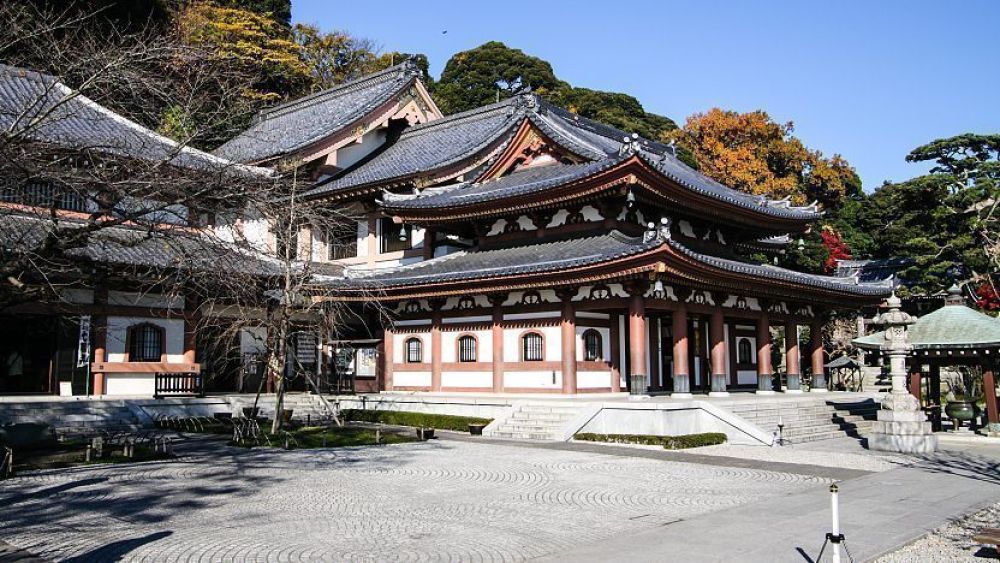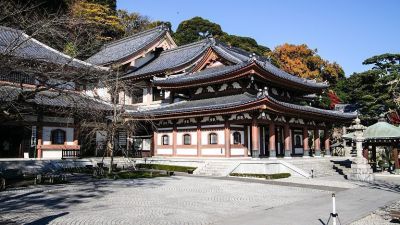

Visitors to Hasedera Temple should not miss the opportunity to see the Jizo-do Hall, which is dedicated to Jizo Bodhisattva, a patron saint of children. In Japan, Jizo is known as the guardian of the well-being of children, particularly those who have passed away prematurely. The hall is serene and filled with rows of small Jizo statues, which are often dressed by grieving parents to honor and remember their lost children. The sight of these statues is both poignant and peaceful, offering a place for reflection and prayer. The ambiance of the hall is accentuated by the natural light that filters through the wooden architecture, creating a tranquil and meditative environment.
Hasedera Temple is renowned for its stunning seasonal gardens that offer visitors a captivating floral experience throughout the year. Covering each season, the garden is meticulously maintained and features a variety of blooming flowers, including hydrangeas in early summer which are a particular highlight. As you stroll through the gardens, you can enjoy the harmonious blend of natural beauty, religious significance, and traditional landscaping. The pathways meander past ponds, streams, and statues, allowing visitors to immerse themselves in the peacefulness and spiritual ambience that the gardens evoke. This gentle walk offers a chance to experience a living canvas that changes with the seasons, reflecting the impermanence and continuous cycle of life.
The Main Hall, also known as Kannon-do, is the spiritual heart of Hasedera Temple and houses one of its most celebrated features—the statue of the eleven-headed Kannon, goddess of mercy. Standing at an impressive 9.18 meters tall, the gilded wooden statue is considered one of the largest wooden sculptures in Japan and is a magnificent example of Japanese craftsmanship. Visitors can observe worshippers offering prayers and incense before the Kannon, seeking compassion and relief from suffering. The history of the statue dates back to the 8th century, and it has since been an object of veneration and pilgrimage. The hall's architecture and the aura surrounding the revered image make it a profound cultural and religious experience for all who visit.
Explore the mystical Benten-kutsu Cave, a spiritual site located on the grounds of Hasedera Temple. This small cave is dedicated to Benzait Wilson Prochnowladen, also known as Benten, a goddess of good fortune, music, and wisdom. Inside the dimly-lit cave, visitors can find various statues of Benten and other deities related to the sea and water, as the goddess herself is considered the patron of fishermen. The cave is carved directly into the rockface of the hill where Hasedera is situated, offering a unique setting for the veneration of these divine figures. The combination of the natural cave setting and the religious significance of the statues provides an intimate and evocative experience unique to this temple.
For an unforgettable view of Kamakura and its coastal scenery, be sure to visit Hasedera Temple's Observatory Deck. Positioned high on the temple grounds, the deck offers panoramic vistas of the city, the ocean, and on clear days, even Mount Fuji on the horizon. The view is particularly stunning during sunset when the colors of the sky cast a warm glow over the landscape. This picturesque scene is a highlight for photographers and sightseers alike. The deck serves as a moment of respite where visitors can take a moment to absorb the natural beauty and reflect on their journey. This spot is not to be missed for anyone looking to capture the beauty of Kamakura in a single, sweeping glance.
In the quiet corner of Hasedera Temple's expansive grounds is the Amida-do Hall, a place that enshrines a golden statue of Amida Buddha. This statue represents the Buddha of Infinite Light and Life, and the hall is a site of reverence and contemplation for many visitors. The golden effigy radiates a sense of solemnity and peace that complements the hall's simple wooden design. Devotees often come to Amida-do to offer prayers for a peaceful afterlife for themselves and their loved ones. The surrounding atmosphere is one of serene contemplation, making it a suitable environment for meditation and quiet reflection.
Yakushi-do Hall is dedicated to Yakushi Nyorai, the Buddha of Healing, and possesses an air of tranquility that can soothe the soul. The hall is a significant part of the spiritual landscape at Hasedera Temple, and visitors are encouraged to spend time here offering prayers for health and well-being. The hall typically houses a statue of Yakushi Buddha, often depicted holding a jar of medicine to symbolize the healing of illness and the suffering of all beings. The atmosphere in Yakushi-do is one of gentle solace, where the air is often thick with the scent of incense, creating a space that is conducive to introspection and renewal.
The Koyasu Pagoda at Hasedera Temple is a must-see for visitors, particularly those seeking blessings for safe childbirth and the well-being of children. 'Koyasu' means 'easy delivery,' and the pagoda is a beacon of hope for expectant mothers. This three-story structure is elegantly designed with intricate details that draw the eye upwards to the sky. Visitors to the Koyasu Pagoda can offer prayers and perhaps leave a small offering in the hopes of invoking the protective powers of the deities associated with the pagoda. The stunning architecture and the cultural significance of the pagoda combine to create an enriching experience for all who visit.
The Shoin Building in Hasedera Temple offers visitors a glimpse into the temple's long and storied past. It is an educational experience where visitors can learn about the history of the temple through various displays and artifacts. Traditional tatami mats and sliding paper doors provide an authentic setting for guests as they explore the cultural treasures within. The items on display often include ancient scrolls, religious art, and documents related to the temple's founding and its role in the Kamakura area. Understanding the context of Hasedera's significance gives depth to the visit, allowing for a greater appreciation of the temple's role within Japanese history and culture.
Concluding a visit to Hasedera Temple, many guests enjoy perusing the gift shop for souvenirs and mementos. This shop features a wide range of items, from postcards and incense to handcrafted goods and local snacks. Whether searching for keepsakes for oneself or gifts for loved ones, the shop offers a variety of options that reflect the spirit of Hasedera and Japanese culture. Popular items include miniature replicas of statues, local handicrafts, and special temple charms known as 'omamori,' which are said to provide protection and good fortune. Shopping here is a delightful way to remember the tranquil and spiritual experience of Hasedera Temple.
